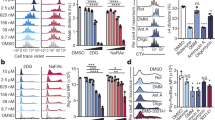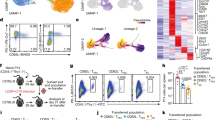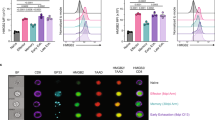Abstract
Despite the increasing knowledge of the molecular events that induce the glycolysis pathway in effector T cells, very little is known about the transcriptional mechanisms that dampen the glycolysis program in quiescent cell populations such as memory T cells. Here we found that the transcription factor Bcl-6 directly repressed genes encoding molecules involved in the glycolysis pathway, including Slc2a1, Slc2a3, Pkm and Hk2, in type 1 helper T cells (TH1 cells) exposed to low concentrations of interleukin 2 (IL-2). Thus, Bcl-6 had a role opposing the IL-2-sensitive glycolytic transcriptional program that the transcription factors c-Myc and HIF-1α promote in effector T cells. Additionally, the TH1 lineage–specifying factor T-bet functionally antagonized the Bcl-6-dependent repression of genes encoding molecules in the glycolysis pathway, which links the molecular balance of these two factors to regulation of the metabolic gene program.
This is a preview of subscription content, access via your institution
Access options
Subscribe to this journal
Receive 12 print issues and online access
$209.00 per year
only $17.42 per issue
Buy this article
- Purchase on Springer Link
- Instant access to full article PDF
Prices may be subject to local taxes which are calculated during checkout







Similar content being viewed by others
References
Yu, D. et al. The transcriptional repressor Bcl-6 directs T follicular helper cell lineage commitment. Immunity 31, 457–468 (2009).
Johnston, R.J. et al. Bcl6 and Blimp-1 are reciprocal and antagonistic regulators of T follicular helper cell differentiation. Science 325, 1006–1010 (2009).
Nurieva, R.I. et al. Bcl6 mediates the development of T follicular helper cells. Science 325, 1001–1005 (2009).
Kaech, S.M. & Cui, W. Transcriptional control of effector and memory CD8+ T cell differentiation. Nat. Rev. Immunol. 12, 749–761 (2012).
Cui, W., Liu, Y., Weinstein, J.S., Craft, J. & Kaech, S.M. An interleukin-21-interleukin-10-STAT3 pathway is critical for functional maturation of memory CD8+ T cells. Immunity 35, 792–805 (2011).
Crotty, S., Johnston, R.J. & Schoenberger, S.P. Effectors and memories: Bcl-6 and Blimp-1 in T and B lymphocyte differentiation. Nat. Immunol. 11, 114–120 (2010).
Pepper, M., Pagan, A.J., Igyarto, B.Z., Taylor, J.J. & Jenkins, M.K. Opposing signals from the Bcl6 transcription factor and the interleukin-2 receptor generate T helper 1 central and effector memory cells. Immunity 35, 583–595 (2011).
Ichii, H. et al. Role for Bcl-6 in the generation and maintenance of memory CD8+ T cells. Nat. Immunol. 3, 558–563 (2002).
Oestreich, K.J., Mohn, S.E. & Weinmann, A.S. Molecular mechanisms that control the expression and activity of Bcl-6 in TH1 cells to regulate flexibility with a TFH-like gene profile. Nat. Immunol. 13, 405–411 (2012).
Kallies, A., Xin, A., Belz, G.T. & Nutt, S.L. Blimp-1 transcription factor is required for the differentiation of effector CD8+ T cells and memory responses. Immunity 31, 283–295 (2009).
Huang, C., Hatzi, K. & Melnick, A. Lineage-specific functions of Bcl-6 in immunity and inflammation are mediated by distinct biochemical mechanisms. Nat. Immunol. 14, 380–388 (2013).
Pearce, E.L., Poffenberger, M.C., Chang, C.H. & Jones, R.G. Fueling immunity: insights into metabolism and lymphocyte function. Science 342, 1242454 (2013).
Wang, R. & Green, D.R. Metabolic checkpoints in activated T cells. Nat. Immunol. 13, 907–915 (2012).
Doedens, A.L. et al. Hypoxia-inducible factors enhance the effector responses of CD8+ T cells to persistent antigen. Nat. Immunol. 14, 1173–1182 (2013).
Wang, R. et al. The transcription factor Myc controls metabolic reprogramming upon T lymphocyte activation. Immunity 35, 871–882 (2011).
van der Windt, G.J. et al. Mitochondrial respiratory capacity is a critical regulator of CD8+ T cell memory development. Immunity 36, 68–78 (2012).
Finlay, D.K. et al. PDK1 regulation of mTOR and hypoxia-inducible factor 1 integrate metabolism and migration of CD8+ T cells. J. Exp. Med. 209, 2441–2453 (2012).
Chang, C.H. et al. Posttranscriptional control of T cell effector function by aerobic glycolysis. Cell 153, 1239–1251 (2013).
van der Windt, G.J. & Pearce, E.L. Metabolic switching and fuel choice during T-cell differentiation and memory development. Immunol. Rev. 249, 27–42 (2012).
Pearce, E.L. et al. Enhancing CD8 T-cell memory by modulating fatty acid metabolism. Nature 460, 103–107 (2009).
Sukumar, M. et al. Inhibiting glycolytic metabolism enhances CD8+ T cell memory and antitumor function. J. Clin. Invest. 123, 4479–4488 (2013).
Choi, Y.S. et al. Bcl6 expressing follicular helper CD4 T cells are fate committed early and have the capacity to form memory. J. Immunol. 190, 4014–4026 (2013).
Crotty, S. Follicular helper CD4 T Cells (TFH). Annu. Rev. Immunol. 29, 621–663 (2011).
Baumjohann, D., Okada, T. & Ansel, K.M. Cutting edge: distinct waves of BCL6 expression during T follicular helper cell development. J. Immunol. 187, 2089–2092 (2011).
Ballesteros-Tato, A. et al. Interleukin-2 inhibits germinal center formation by limiting T follicular helper cell differentiation. Immunity 36, 847–856 (2012).
Johnston, R.J., Choi, Y.S., Diamond, J.A., Yang, J.A. & Crotty, S. STAT5 is a potent negative regulator of TFH cell differentiation. J. Exp. Med. 209, 243–250 (2012).
Pipkin, M.E. et al. Interleukin-2 and inflammation induce distinct transcriptional programs that promote the differentiation of effector cytolytic T cells. Immunity 32, 79–90 (2010).
Hurtz, C. et al. BCL6-mediated repression of p53 is critical for leukemia stem cell survival in chronic myeloid leukemia. J. Exp. Med. 208, 2163–2174 (2011).
Oestreich, K.J., Huang, A.C. & Weinmann, A.S. The lineage-defining factors T-bet and Bcl-6 collaborate to regulate Th1 gene expression patterns. J. Exp. Med. 208, 1001–1013 (2011).
Hatzi, K. et al. A hybrid mechanism of action for BCL6 in B cells defined by formation of functionally distinct Complexes at enhancers and promoters. Cell Reports 4, 578–588 (2013).
Chapuy, B. et al. Discovery and characterization of super-enhancer-associated dependencies in diffuse large B cell lymphoma. Cancer Cell 24, 777–790 (2013).
Swaminathan, S. et al. BACH2 mediates negative selection and p53-dependent tumor suppression at the pre-B cell receptor checkpoint. Nat. Med. 19, 1014–1022 (2013).
Liao, W. et al. Opposing actions of IL-2 and IL-21 on Th9 differentiation correlate with their differential regulation of BCL6 expression. Proc. Natl. Acad. Sci. USA 111, 3508–3513 (2014).
The ENCODE Project Consortium. A user's guide to the Encyclopedia of DNA Elements (ENCODE). PLoS Biol. 9, e1001046 (2011).
Mimura, I. et al. Dynamic change of chromatin conformation in response to hypoxia enhances the expression of GLUT3 (SLC2A3) by cooperative interaction of hypoxia-inducible factor 1 and KDM3A. Mol. Cell. Biol. 32, 3018–3032 (2012).
Joshi, N.S. et al. Inflammation directs memory precursor and short-lived effector CD8+ T cell fates via the graded expression of T-bet transcription factor. Immunity 27, 281–295 (2007).
Intlekofer, A.M. et al. Requirement for T-bet in the aberrant differentiation of unhelped memory CD8+ T cells. J. Exp. Med. 204, 2015–2021 (2007).
Rao, R.R., Li, Q., Odunsi, K. & Shrikant, P.A. The mTOR kinase determines effector versus memory CD8+ T cell fate by regulating the expression of transcription factors T-bet and Eomesodermin. Immunity 32, 67–78 (2010).
Rochman, Y., Spolski, R. & Leonard, W.J. New insights into the regulation of T cells by γc family cytokines. Nat. Rev. Immunol. 9, 480–490 (2009).
Liao, W., Lin, J.X. & Leonard, W.J. Interleukin-2 at the crossroads of effector responses, tolerance, and immunotherapy. Immunity 38, 13–25 (2013).
Basso, K. & Dalla-Favera, R. Roles of BCL6 in normal and transformed germinal center B cells. Immunol. Rev. 247, 172–183 (2012).
Basso, K. & Dalla-Favera, R. BCL6: master regulator of the germinal center reaction and key oncogene in B cell lymphomagenesis. Adv. Immunol. 105, 193–210 (2010).
Pearce, E.L. & Pearce, E.J. Metabolic pathways in immune cell activation and quiescence. Immunity 38, 633–643 (2013).
Choi, Y.S., Yang, J.A. & Crotty, S. Dynamic regulation of Bcl6 in follicular helper CD4 T (Tfh) cells. Curr. Opin. Immunol. 25, 366–372 (2013).
Nakayamada, S. et al. Early Th1 cell differentiation is marked by a Tfh cell-like transition. Immunity 35, 919–931 (2011).
Denko, N.C. Hypoxia, HIF1 and glucose metabolism in the solid tumour. Nat. Rev. Cancer 8, 705–713 (2008).
Duy, C. et al. BCL6 enables Ph+ acute lymphoblastic leukaemia cells to survive BCR-ABL1 kinase inhibition. Nature 473, 384–388 (2011).
Bernstein, B.E. et al. An integrated encyclopedia of DNA elements in the human genome. Nature 489, 57–74 (2012).
Miller, S.A., Huang, A.C., Miazgowicz, M.M., Brassil, M.M. & Weinmann, A.S. Coordinated but physically separable interaction with H3K27-demethylase and H3K4-methyltransferase activities are required for T-box protein-mediated activation of developmental gene expression. Genes Dev. 22, 2980–2993 (2008).
Beima, K.M. et al. T-bet binding to newly identified target gene promoters is cell type-independent but results in variable context-dependent functional effects. J. Biol. Chem. 281, 11992–12000 (2006).
Miller, S.A., Mohn, S.E. & Weinmann, A.S. Jmjd3 and UTX play a demethylase-independent role in chromatin remodeling to regulate T-box family member-dependent gene expression. Mol. Cell 40, 594–605 (2010).
Barrett, T. et al. NCBI GEO: archive for functional genomics data sets–update. Nucleic Acids Res. 41, D991–D995 (2013).
Acknowledgements
We thank D. Rawlings (University of Washington) for human Ramos B cells; the preclinical repository of the National Cancer Institute for IL-2 and anti-IL-4; M. Wijaranakula for technical assistance; D. Chisolm for critical reading of the manuscript; and A. Ballesteros-Tato, B. Leon and T. Dadali-Abel for advice and assistance. Supported by the National Institute of Allergy and Infectious Diseases (AI061061 to A.S.W.) and the American Cancer Society (RSG-09-045-01-DDC to A.S.W.).
Author information
Authors and Affiliations
Contributions
K.J.O. and A.S.W. conceived of and designed the study, performed experiments, analyzed data and wrote the manuscript; and K.A.R., S.E.G., K.P.H., P.W.M. and V.K. performed experiments and analyzed data sets.
Corresponding authors
Ethics declarations
Competing interests
The authors declare no competing financial interests.
Integrated supplementary information
Supplementary Figure 1 IL-2 signaling regulates the expression of genes encoding molecules in the glycolysis pathway in CD8+ TC1 cells.
Primary CD8+ T cells were cultured in TC1 polarizing conditions (IL-12 and anti-IL-4) with either high (white bars) or low (black bars) IL-2 conditions. Transcript abundance for the indicated genes was determined by quantitative RT-PCR using the BioRad PrimePCR system with primers specific to the indicated genes. Relative expression was normalized to the Rps18 control followed by comparison relative to the high IL-2 condition (set to 1). Three independent experiments were performed and the error bars represent the standard error of the mean (SEM). *P < 0.05, **P < 0.01, ***P < 0.001 (unpaired Student’s t-test).
Supplementary Figure 2 IL-2 signaling regulates the expression of genes encoding molecules in the glycolysis pathway in CD8+ TC1 cells and CD4+ TH1 cells.
(a) Primary CD8+ or (b) CD4+ T cells were cultured in TC1/TH1 (IL-12 and anti-IL-4) conditions, with either high (white bars) or low (black bars) IL-2. Transcript amounts were determined as described in Supplementary Fig. 1. (a, b) Three independent experiments were performed and the error bars represent SEM. *P < 0.05, **P < 0.01, ***P < 0.001 (unpaired Student’s t-test).
Supplementary Figure 3 IL-2 signaling regulates the expression of genes encoding molecules in the glycolysis pathway in CD4+ TH1 cells.
Primary CD4+ T cells were cultured in TH1 polarizing conditions with either high (white bars) or low (black bars) IL-2. Transcript abundance was determined as indicated in Supplementary Fig. 1. Three independent experiments were performed and the error bars represent SEM. *P < 0.05, **P < 0.01, ***P < 0.001 (unpaired Student’s t-test).
Supplementary Figure 4 Bcl-6 and c-Myc–HIF-1α have inverse roles in regulating genes encoding molecules involved in glycolysis.
(a, b) EL4 T cells were co-transfected with (a) the P4ha2-promoter-reporter construct or (b) the pGL3-promoter vector in combination with either an empty vector control (white bars) or one expressing Bcl-6 (black bars). Luciferase promoter-reporter values were normalized to a renilla control and expressed relative to the control sample (set to 1). (c, d) ChIP experiments were performed with TH1 polarized cells maintained in either low (black bars) or high (white bars) IL-2 conditions. Chromatin samples were immunoprecipitated with antibodies specific to (c) Bcl-6, (d) c-Myc, HIF-1α, or (c, d) a nonspecific IgG antibody control. The indicated promoter regions were monitored by qPCR and the values for the precipitated samples were determined as described in Fig. 3c. Either (c) at least two, (d) three, (b) four, or (a) five independent experiments were performed with the error bars representing SEM. *P < 0.05, **P < 0.01, ***P < 0.001 (unpaired Student’s t-test).
Supplementary Figure 5 Bcl-6 expression represses the endogenous expression of genes encoding molecules in the glycolysis pathway in primary CD4+ TH1 cells maintained in conditions of a high concentration of IL-2.
Primary CD4+ T cells were cultured in TH1 conditions with high IL-2 concentrations. The cells were transfected with either a control (white bars) or Bcl-6 (black bars) expression vector. Cells were placed back in high IL-2 conditions and then RNA was harvested 24 h later. Relative expression was determined by quantitative RT-PCR analysis using the BioRad PrimePCR system customized with primers specific to the indicated genes. Samples were first normalized to the expression of Rps18 and then compared to the control sample (set to 1) in each independent experiment. Three independent experiments were performed and the error bars represent SEM. The P value for Egln3 was 0.0564 and was not quite statistically significant. *P < 0.05, **P < 0.01, ***P < 0.001 (unpaired Student’s t-test).
Supplementary Figure 6 Genomic distribution of Bcl-6, HIF-1α and c-Myc surrounding the loci of genes encoding molecules of the glycolysis pathway.
Shown are images derived from the UCSC genome browser displaying ChIP-seq peak tracks for BCOR, SMRT, three independent Bcl-6 experiments, HIF-1α in hypoxic conditions, and ENCODE c-Myc data as described in Fig. 4 and Methods.
Supplementary Figure 7 The relative balance between T-bet and Bcl-6 regulates the expression of genes encoding molecules in the glycolysis pathway.
(a-c) Primary wild-type (white bars) or Tbx21-/- (black bars) CD4+ T cells were cultured in TH1 polarizing conditions. Transcript expression for the indicated genes was determined as described in Fig. 6a. (d) Primary CD4+ T cells isolated from either wild-type (white bars) or Tbx21-/- (black bars) mice were treated as in (a). Chromatin samples were immunoprecipitated with an antibody specific to H3K9Ac or a nonspecific IgG antibody control and quantitated as described in Fig. 3c. (a-d) Three independent experiments were performed and error bars represent SEM. *P < 0.05, **P < 0.01, ***P < 0.001 (unpaired Student’s t-test).
Supplementary Figure 8 The C-terminal domain of T-bet inhibits the Bcl-6-dependent repression of genes encoding molecules in the glycolysis pathway.
(a) V5-epitope tagged expression constructs for T-bet(300-530), T-bet(120-331), or an empty vector control were transfected into A20 cells. Note that the T-bet(120-331) construct contains a point mutation in a required DNA-binding amino acid. An immunoblot analysis was performed using a V5 specific antibody to detect construct expression. (b) Untreated A20 cells or A20 cells treated with PMA and ionomycin (P/I) were harvested and lysates were subjected to an immunoblot analysis to assess Bcl-6 expression. Gapdh was monitored as a protein loading control. (c) Transfected samples from Fig. 7b were split into two independent wells and one was treated with P/I. Results are expressed as described in Fig. 7b. (d) A20 cells were co-transfected with the indicated promoter-reporter constructs and either an empty vector control (black bars), T-bet(120-331) (grey bars) or T-bet(300-530) (white bars). Luciferase promoter-reporter values were determined as described in Fig. 7b. (e) Ramos human B cells were transfected with either an empty vector control (black bars) or one expressing T-bet(300-530) (white bars) and stimulated with anti-CD40. Transcript abundance for the indicated endogenous genes were analyzed by quantitative RT-PCR and normalized to the Rps18 control. The graph represents the normalized expression in comparison to the control sample (set to 1). (a-e) Three independent experiments were performed and (c-e) the error bars represent SEM. *P < 0.05, **P < 0.01, ***P < 0.001 (unpaired Student’s t-test).
Supplementary Figure 9 The C-terminal domain of T-bet inhibits the Bcl-6-dependent repression of the endogenous expression of a subset of genes encoding molecules of the glycolysis pathway.
A20 murine B cells were transfected with either an empty vector control (black bars) or T-bet(300-530) (white bars). Transcript amounts for the indicated endogenous genes were analyzed by quantitative RT-PCR using PrimePCR plates and normalized to the Rps18 control. The sample expression was compared relative to the control sample (set to 1). Three independent experiments were performed and the error bars represent SEM. The P values for Slc2a1 and Tpi1 were less than 0.0549, but did not quite reach statistical significance (NS). *P < 0.05, **P < 0.01, ***P < 0.001 (unpaired Student’s t-test).
Supplementary information
Supplementary Text and Figures
Supplementary Figures 1–9 and Supplementary Table 1 (PDF 3366 kb)
Rights and permissions
About this article
Cite this article
Oestreich, K., Read, K., Gilbertson, S. et al. Bcl-6 directly represses the gene program of the glycolysis pathway. Nat Immunol 15, 957–964 (2014). https://doi.org/10.1038/ni.2985
Received:
Accepted:
Published:
Issue Date:
DOI: https://doi.org/10.1038/ni.2985
This article is cited by
-
Interleukin-2 and regulatory T cells in rheumatic diseases
Nature Reviews Rheumatology (2021)
-
Germinal center B cells selectively oxidize fatty acids for energy while conducting minimal glycolysis
Nature Immunology (2020)
-
Metabolic coordination of T cell quiescence and activation
Nature Reviews Immunology (2020)
-
T cell metabolism: new insights in systemic lupus erythematosus pathogenesis and therapy
Nature Reviews Rheumatology (2020)
-
Immune metabolism regulation of the germinal center response
Experimental & Molecular Medicine (2020)



